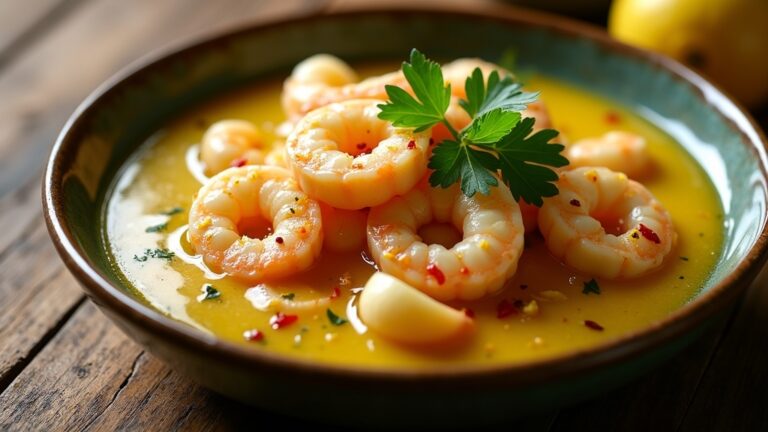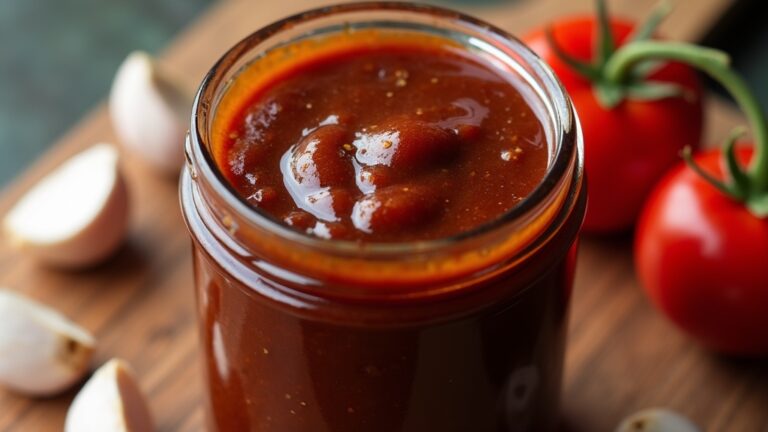Pizza Sauce Recipe
To whip up a delicious pizza sauce, start with a can of whole peeled tomatoes, then add olive oil, minced garlic, and dried oregano and basil. Simmer them together for robust flavors, then blend for a smooth consistency. Season with sugar, salt, and pepper to taste. It’s easy, fresh, and far better than store-bought. With just a few simple steps, you can elevate your pizza game, and there’s more to explore for flavor enhancements and customization options!
Contents
History
When you plunge into the world of pizza sauce, you’re not just savoring a flavorful blend; you’re also tasting a rich history that dates back centuries. Originating in ancient Italy, the first pizza sauces were simple yet vibrant, made from crushed tomatoes, herbs, and a dash of olive oil. These ancient recipes laid the foundation for what would become a cornerstone of Italian cuisine. As pizza spread across the globe, variations emerged, each reflecting local tastes while honoring traditional methods. You’ll discover that each bite is a journey through time, connecting you to the artisans who crafted these sauces with care. Embracing this history offers you a deeper appreciation for the bold flavors that define pizza sauce today.
Recipe
Making your own pizza sauce can greatly elevate your homemade pizza experience. Unlike store-bought options, a homemade sauce allows you to control the flavors and ingredients, ensuring a fresh and vibrant taste. The beauty of this sauce lies in its simplicity and the ability to customize it to your preference. You can adjust the seasoning, add a bit of heat, or even incorporate other herbs to match your favorite pizza toppings.
Elevate your pizza night by making homemade sauce, allowing for fresh flavors and personalized seasoning to match your favorite toppings.
To begin this culinary adventure, gather your ingredients and prepare for a delightful sauce that will complement any pizza creation. The key to a great pizza sauce is using high-quality tomatoes, whether they are canned San Marzano tomatoes or ripe fresh ones in season. With just a few simple steps, you’ll be on your way to making a delicious sauce that enhances the flavor of your pizza and leaves your guests craving more.
Ingredients:
- 1 can (28 ounces) of whole peeled tomatoes
- 2 tablespoons olive oil
- 3 cloves garlic, minced
- 1 teaspoon dried oregano
- 1 teaspoon dried basil
- ½ teaspoon sugar
- Salt and pepper to taste
- Red pepper flakes (optional)
Instructions:
In a blender or food processor, pulse the whole peeled tomatoes until smooth or to your desired consistency. In a medium saucepan, heat the olive oil over medium heat and sauté the minced garlic until fragrant, about 30 seconds. Add the blended tomatoes, oregano, basil, sugar, salt, and pepper to the saucepan. Simmer the sauce on low heat for about 15-20 minutes, stirring occasionally, until it thickens slightly and the flavors meld together.
Extra Tips:
For an extra depth of flavor, try roasting your garlic before adding it to the sauce. Additionally, if you prefer a chunkier sauce, skip the blending step and crush the tomatoes by hand instead. Feel free to experiment with fresh herbs like parsley or thyme or add a splash of balsamic vinegar for a unique twist. This sauce can be stored in the refrigerator for up to one week or frozen for future use, making it a convenient option for quick pizza nights.
Cooking Steps
To create your perfect pizza sauce, start by gathering fresh tomatoes, the heart of your sauce. You’ll then simmer them with a blend of herbs and spices, releasing their rich flavors. Finally, blending until smooth and adding a splash of olive oil will bring everything together, making it irresistible.
Step 1. Gather Fresh Tomatoes
Fresh tomatoes are the heart of any great pizza sauce, so it’s crucial to choose the best ones you can find. Start by exploring local farmer’s markets or gardens, where you’ll discover a variety of fresh tomato varieties bursting with flavor. Here’s how to gather your tomatoes like a pro:
- Look for vibrant colors; deep reds and greens indicate ripeness.
- Gently squeeze each tomato; it should yield slightly without being mushy.
- Check for blemishes or bruises; you want perfect specimens for your sauce.
- Use proper tomato harvesting techniques by twisting the stem to avoid damage.
With these tips, you’ll guarantee your pizza sauce is packed with the freshest, most delicious tomatoes available!
Step 2. Simmer With Herbs and Spices
As you prepare to transform your gathered tomatoes into a vibrant sauce, simmering them with a harmonious blend of herbs and spices is essential. Start with classic herb combinations like fresh basil, oregano, and thyme—these will elevate your sauce to new heights. You’ll want to experiment with spice ratios, adding garlic powder and red pepper flakes for depth and a hint of heat. Allow the mixture to bubble gently; this melds the flavors beautifully. Keep an eye on the aroma; it should be inviting and comforting. Simmer for about 30 minutes, stirring occasionally, until the tomatoes break down and the sauce thickens. This step is where your sauce truly comes alive, bursting with a symphony of flavors that’ll make your pizza unforgettable.
Step 3. Blend Until Smooth
Once your sauce has simmered to perfection, it’s time to blend it into a velvety smooth consistency. This step is where the magic happens, transforming your rich mixture into a flavorful base for your pizza. Here are some effective blending techniques to achieve that ideal sauce consistency:
- Use an immersion blender for quick and easy blending directly in the pot.
- Transfer to a countertop blender for a thorough mix, blending in batches if necessary.
- Add a splash of water if the sauce feels too thick; this helps achieve a pourable texture.
- Pulse the blender to control the consistency, ensuring you don’t over-blend and lose that fresh flavor.
Embrace the freedom of creating your perfect pizza sauce!
Step 4. Add Olive Oil
To elevate your pizza sauce, adding a drizzle of olive oil is essential. Not only does it enrich the flavor, but it also brings along numerous olive oil benefits. Choosing the right type of olive oil can make all the difference. Extra virgin olive oil is often the best choice, boasting a robust taste and high-quality antioxidants. You’ll want to pour in about one to two tablespoons of this liquid gold after blending your sauce until smooth. As you mix, watch how the oil enhances the texture, giving it a luscious, velvety finish. With every spoonful, you’ll savor the harmony of flavors, making your pizza sauce truly irresistible. Enjoy this simple step for a gourmet touch!
Step 5. Adjust Seasoning to Taste
After adding that rich drizzle of olive oil, it’s time to focus on the seasoning. Achieving the perfect seasoning balance is vital to cater to your taste preferences, so let’s explore the essentials. Start with a pinch of salt to enhance the flavors, followed by:
- Garlic powder – adds a warm depth.
- Dried oregano – infuses that classic Italian touch.
- Crushed red pepper flakes – for a spicy kick, if you dare.
- Sugar – to mellow acidity and round out the sauce.
Nutritional Guide
While enjoying a slice of pizza, you might not think about the nutritional impact of the sauce slathered on top. Understanding its caloric content and ingredient benefits can enhance your pizza experience. The sauce is typically low in calories and packed with nutrients from tomatoes, herbs, and spices. Here’s a quick glance at the nutritional breakdown:
| Nutrient | Amount per 1/4 cup |
|---|---|
| Calories | 30 |
| Protein | 1g |
| Fat | 0g |
| Carbohydrates | 7g |
Final Thoughts
Understanding the nutritional aspects of pizza sauce can enhance your overall enjoyment and appreciation of this beloved topping. With a bit of creativity, you can explore sauce variations that suit your taste. Here are some storage tips to keep your sauce fresh and flavorful:
- Refrigeration: Store unused sauce in an airtight container for up to a week.
- Freezing: Pour sauce into ice cube trays, freeze, and transfer to a freezer bag for easy portioning.
- Herb Infusion: Experiment with different herbs like basil or oregano to elevate your sauce.
- Spice It Up: Add chili flakes for a kick, or sugar for sweetness, adjusting to your preference.
Embrace the freedom to customize and enjoy pizza sauce that’s uniquely yours!
Frequently Asked Questions
Can I Use Canned Tomatoes for Pizza Sauce?
Absolutely, you can use canned tomatoes for your sauce! They create a rich flavor and can help achieve the perfect sauce consistency. Just blend them well, and you’re ready for a delicious pizza night!
How Long Can I Store Homemade Pizza Sauce?
You might worry about storing homemade sauces, but with proper storage tips, you can enjoy your pizza sauce for up to a week in the fridge or three months in the freezer—maximizing its shelf life effortlessly!
Is Pizza Sauce Different From Marinara Sauce?
Yes, pizza sauce differs from marinara sauce. You’ll notice pizza sauce has a thicker consistency, while marinara boasts a smoother texture. Their flavor profiles also vary, with pizza sauce often being more concentrated and savory.
Can I Freeze Leftover Pizza Sauce?
Yes, you can freeze leftover pizza sauce! For best results, use airtight containers, label them, and leave some space for expansion. These freezing tips guarantee your sauce stays fresh for future culinary adventures. Enjoy hassle-free sauce storage!
What Spices Can I Add to Enhance Flavor?
To enhance flavor, consider adding oregano variations for depth and richness. You can also explore garlic options, like roasted or powdered garlic, to elevate the sauce’s aroma and taste, creating a vibrant culinary experience.
Conclusion
As you savor your homemade pizza sauce, think of the bustling streets of Naples, where every bite tells a story steeped in tradition. You’ve transformed simple ingredients into a culinary masterpiece that rivals the greats. Whether you’re crafting a classic Margherita or a zesty pepperoni, this sauce elevates your creation to new heights. So, roll up your sleeves and embrace your inner pizzaiolo—after all, every great pizza starts with a great sauce, and yours is nothing short of legendary.



